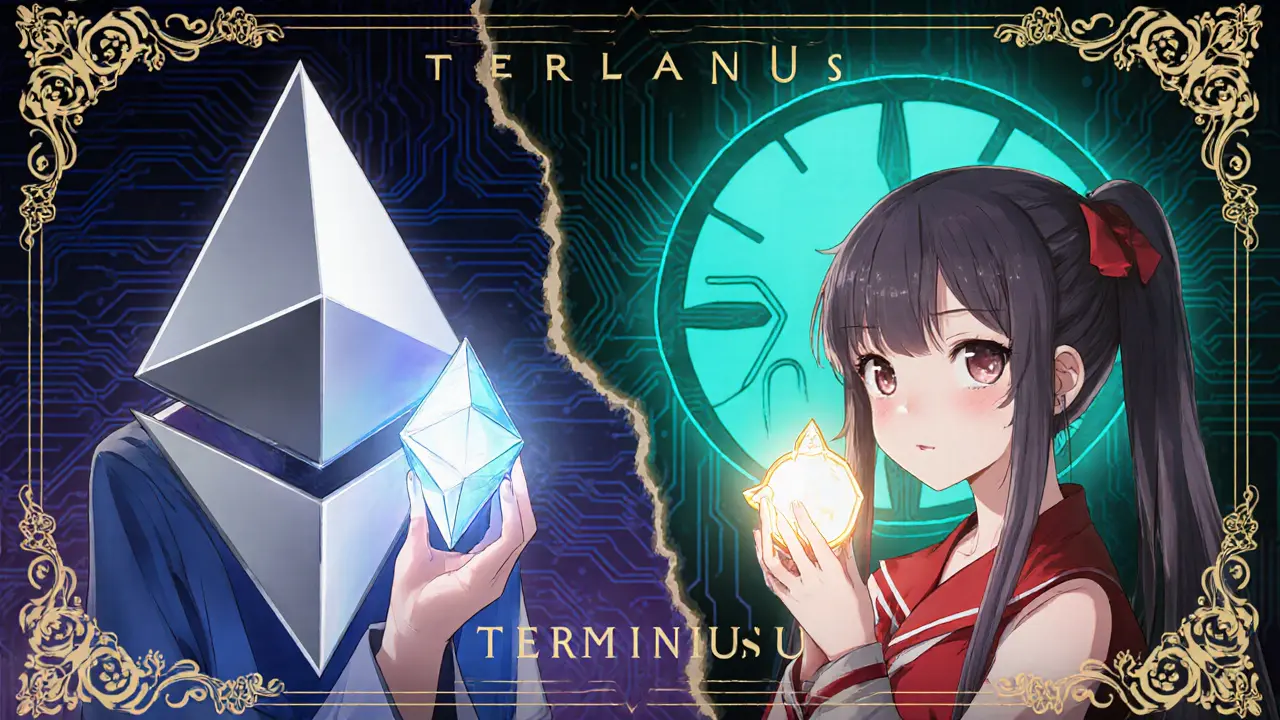TERMINUS crypto coin explained: price, tech, and risk assessment

Meme Coin Risk Calculator
Investment Calculator
Risk Assessment
Potential Loss Estimate
Based on current liquidity, you could lose up to 98% of your investment
WARNING: This is an ultra-low liquidity token. You may not be able to sell at all.
The market data shows near-zero trading volume. Most orders never fill.
Ever stumbled on a token called TERMINUS - a meme‑style cryptocurrency that riffs on Elon Musk’s Mars ideas and wondered what the hype is really about? You’re not alone. The coin pops up on obscure exchange lists, gets a few optimistic price forecasts, and then disappears from trade screens for days. This guide breaks down everything you need to know: where the token lives, how it’s built (or not), what the market says, and why most experts advise staying far away.
Key Takeaways
- TERMINUS is marketed as a meme coin tied to space‑exploration themes, with no clear technical roadmap.
- Sources disagree on its blockchain: some list it as an ERC‑20 token on Ethereum, others claim a Solana implementation.
- Current market data shows a price under $0.0000001, market cap around $22k, and daily volume under $10 - essentially illiquid.
- Expert analyses range from wildly optimistic price targets to warnings of “guaranteed loss” for retail investors.
- Practical trading is nearly impossible; most users report orders hanging for days with no takers.
What is TERMINUS?
TERMINUS (ticker: TERMINUS) is a community‑driven meme token that draws its name from a February 2020 tweet by Elon Musk, where he mentioned “Terminus” as a possible name for the first Martian city. The project never released a whitepaper or a detailed roadmap. Its narrative leans heavily on space‑colonization hype rather than any unique blockchain feature.
Technical Foundations - Ethereum or Solana?
The biggest point of confusion is the underlying blockchain. According to HTX’s September 2024 documentation, TERMINUS is an Ethereum ERC‑20 token living on the Ethereum network. In contrast, CoinSwitch’s October 2024 report claims the token runs on Solana known for high‑speed, low‑cost transactions. No official smart‑contract address has been verified on either chain, and GitHub shows no repository linked to the project. This ambiguity suggests the token may be listed on multiple block explorers under different contract addresses, or that the data is simply inaccurate.
Current Market Snapshot
As of the latest reliable data (CoinMarketCap, 19 Oct 2023), TERMINUS trades at roughly $0.0000001537 with zero 24‑hour volume. A later snapshot from TradeSanta (28 Sep 2024) shows a price of $0.00000005, a market cap of $21,780, and a daily volume of $8.2. Whether you look at the Ethereum‑oriented listing or the Solana claim, the token sits in the ultra‑low‑cap, ultra‑low‑liquidity corner of the market.
| Attribute | Ethereum (ERC‑20) | Solana |
|---|---|---|
| Standard | ERC‑20 | SPL Token |
| Launch Date | 2023 (reported) | 2023 (reported) |
| Current Price (USD) | $0.0000001537 | $0.00000005 |
| Market Cap (USD) | $21,800 ≈ | $21,800 ≈ |
| 24‑hr Volume (USD) | $0 (CoinMarketCap) | $8.2 (TradeSanta) |
| Liquidity | Virtually none | Virtually none |
Risk Profile - Why Most Experts Warn Against It
Multiple industry voices paint a stark picture:
- Messari’s Q3 2024 meme‑coin report notes that 99.2 % of tokens with market caps under $50 k disappear within 18 months. TERMINUS fits that bucket.
- Analyst Michael van de Poppe called ultra‑low‑cap meme coins “virtually guaranteed losses for retail investors” in a CoinDesk interview (12 Oct 2024).
- The SEC’s September 2024 warning singled out tokens with zero genuine trading activity as “the purest form of securities violations.”
- Real‑world user stories are grim: on HTX’s forum a trader reported a three‑day order that never filled; on Reddit a user lost $200 because the token never moved.
All signs point to a high probability of total loss, either through abandonment or manipulation.

Optimistic Forecasts - Do They Hold Water?
DigitalCoinPrice published a speculative price target of $0.44 by 2032, an astronomical 286 million % jump. The methodology explicitly states the numbers are based purely on historical patterns, not on any fundamental development. Such projections are mathematically possible but practically meaningless given the token’s lack of liquidity, community, and technical substance.
How (or Whether) to Trade TERMINUS
If you still want to dabble, here’s a realistic checklist:
- Verify the contract address on both Ethereum and Solana explorers. Mismatched addresses often signal a scam.
- Check whether any reputable exchange lists the token. As of late 2024, only HTX showed a listing, and even there the order book is empty most of the time.
- Use a wallet that supports both ERC‑20 and SPL tokens (e.g., Metamask for Ethereum, Phantom for Solana) and keep a tiny amount for gas/transaction fees.
- Set a strict loss limit. Given the $8‑daily volume, any sell order larger than a few hundred tokens will likely never fill.
- Stay alert for pump‑and‑dump signals on social media. The community on X (formerly Twitter) has fewer than 300 followers and no activity since early 2023.
In practice, most users end up with a dead address and a loss they can’t recoup.
Final Thoughts
TERMINUS embodies the wild‑west side of the crypto world: a catchy name, a meme‑coin label, and a handful of optimistic forecasts that ignore the hard numbers. The token’s technical identity is fuzzy, its market data shows virtually zero liquidity, and credible analysts flag it as a near‑certain loss. If you’re looking for a speculative gamble with a remote chance of a moonshot, it fits the bill-just don’t expect to walk away with anything more than a cautionary tale. For most investors, the smarter move is to steer clear and focus on assets with transparent tech, active development, and real trading volume.
Is TERMINUS listed on any major exchange?
As of late 2024, the only exchange showing a listing is HTX, and even there the order book is practically empty. Major platforms like Binance, Coinbase, and Kraken do not list TERMINUS.

Can I buy TERMINUS with fiat currency?
Direct fiat purchase isn’t supported. You’d need to acquire a more liquid crypto (e.g., ETH or SOL), transfer it to a wallet that supports the appropriate token standard, and then attempt a swap on a decentralized exchange-though liquidity is virtually zero.
What’s the biggest red flag for TERMINUS?
The combination of zero daily trading volume, no verifiable whitepaper, and contradictory blockchain claims (Ethereum vs. Solana) is a major warning sign. Add in the lack of an active development team and you have a classic “ghost token.”
Are the price predictions for TERMINUS realistic?
Most forecasts, like DigitalCoinPrice’s $0.44 target for 2032, are purely speculative and ignore the token’s illiquidity and near‑zero market cap. Treat them as entertainment, not financial advice.
Should I keep my TERMINUS holdings for the long term?
Given the high risk of total loss and the lack of any development roadmap, the safest approach is to sell any holdings-even at a loss-if you can find a buyer. Holding for years is unlikely to change the outcome.
Bottom line: The token may look interesting because of its Mars‑related branding, but the data tells a different story. If you value your capital, steer clear of TERMINUS and focus on assets with proven utility and active markets.







Prerna Sahrawat
October 19, 2025 AT 08:29TERMINUS reads like a marketing gimmick that tries to graft Elon Musk's interplanetary fantasies onto the low‑cap meme‑coin playbook, and the result is a textbook case of hype without substance. The branding leans heavily on the romanticism of colonizing Mars, yet the token offers no technical roadmap, no verifiable smart‑contract address, and certainly no development team to speak of. Investors are lured by the allure of a name that sounds futuristic, only to find a project that exists in a fog of contradictory claims about whether it lives on Ethereum or Solana. This ambiguity is not just a minor detail-it is a red flag that the token may be deliberately obfuscating its true nature. The market data corroborates the suspicion: sub‑penny pricing, a market cap that barely reaches twenty‑two thousand dollars, and daily trading volume that hovers around single‑digit dollars. Such illiquidity makes any attempt to buy or sell a near‑impossible task, as orders sit idle for days without any counterpart. Moreover, the lack of an audited contract means that even the token's basic code cannot be trusted to behave as advertised. When you combine these factors-a vague narrative, zero‑volume trading, and no verifiable code-you get a high‑risk speculative vehicle that is more likely to evaporate than to moon. The term “guaranteed loss” used by analysts is not an exaggeration but rather a realistic assessment of the odds. Even the most optimistic price forecasts, which poke at the absurd of a $0.44 target, ignore the reality that without liquidity, price is a meaningless number. In short, TERMINUS embodies the classic pitfalls of meme‑coins that ride on trending topics without delivering any real utility or community support.
Anna Kammerer
October 21, 2025 AT 18:49So you’ve got a token that’s basically a Mars meme with zero volume-yeah, that’s a recipe for a spectacular flop. The whole thing feels like a joke that got lost in translation between Discord hype and actual market mechanics, and the sarcasm is that the only thing taking off is the hype, not the price.
Mike GLENN
October 24, 2025 AT 05:09I totally get why some people are drawn to the shiny branding, but when you peel back the layers you see a ghost token. The lack of a clear blockchain, coupled with the fact that the on‑chain data is either missing or contradictory, is enough to keep even the most adventurous speculators at bay.
BRIAN NDUNG'U
October 26, 2025 AT 14:29From a formal standpoint, the absence of a documented whitepaper and a verifiable contract address signifies a breach of due diligence. Potential investors should refrain from allocating capital to assets lacking foundational transparency.
Ryan Comers
October 29, 2025 AT 00:49🚀🚀🚀
Molly van der Schee
October 31, 2025 AT 11:09While the cosmic theme is alluring, the pragmatic view reminds us that without liquidity, even the most poetic narrative won’t get you any real returns. Think of it as a philosophy lesson on the difference between dream and reality; the coin lives in the former.
Mike Cristobal
November 2, 2025 AT 21:29Another classic case of a token that should stay in the museum of failed experiments. 😒
Johanna Hegewald
November 5, 2025 AT 07:49If you’re looking to actually trade, you’ll need a wallet that supports both ERC‑20 and SPL tokens, but honestly, you’ll probably waste more on gas than you’ll ever make back.
Benjamin Debrick
November 7, 2025 AT 18:09Ah, the ever‑so‑mysterious TERMINUS-where does it live? On Ethereum? On Solana? Perhaps it exists in a parallel blockchain universe, ever‑present yet never‑seen; truly a marvel of modern confusion!!!
mike ballard
November 10, 2025 AT 04:29From a cultural diffusion perspective, this token attempts to leverage extraterrestrial branding to generate network externalities, yet fails to establish any substantive protocol‑level interoperability, rendering the meme superficially viral but fundamentally inert.
Erik Shear
November 12, 2025 AT 14:49Look, it's simple-no volume, no point. Skip it.
Tom Glynn
November 15, 2025 AT 01:09Exactly. The coin's narrative may be exciting, but without an active community or real trading pairs, any optimism is purely philosophical. It reminds me of a thought experiment: imagine a token that never moves; what value does it hold?
Andrew Smith
November 17, 2025 AT 11:29Honestly, the only collaboration happening here is between hype and disappointment. No one should consider this a viable investment.
Joy Garcia
November 19, 2025 AT 21:49Someone told me the moon is made of cheese, and now I’m hearing about a token named Terminus that’s as real as that claim. The whole thing feels like a secret society prank-colorful, dramatized, but ultimately harmless unless you hand over cash.
Jessica Pence
November 22, 2025 AT 08:09Just a heads up: the token’s little to no activity means you’re likely to lose whatever you put in-no matter how tiny.
johnny garcia
November 24, 2025 AT 18:29In sum, the absence of a verifiable contract and the contradictory blockchain claims render TERMINUS an implausible financial instrument; investors should heed the prevailing warnings and redirect capital toward assets backed by tangible development.
Tom Grimes
November 27, 2025 AT 04:49I feel compelled to point out that these kinds of tokens feed on the emotional vulnerabilities of people seeking quick riches; they prey on hope and inflate expectations, only to leave a trail of disappointment that can affect mental well‑being. It's a vicious cycle that the crypto community must address.
Paul Barnes
November 29, 2025 AT 15:09Maybe the real conspiracy is that the token exists just to test how many will fall for a Martian gimmick.
John Lee
December 2, 2025 AT 01:29When you dig into the details, the token looks like a textbook example of a pump‑and‑dump scheme, albeit with a very thin pump. Its lack of community engagement and absent development roadmap serve as red flags that any serious investor should note before committing capital.
Ty Hoffer Houston
December 4, 2025 AT 11:49From my perspective, it’s just another fleeting meme that will fade once the novelty wears off. No need to waste time on it.
Donnie Bolena
December 6, 2025 AT 22:09Honestly!!! This token is a perfect storm of hype, no liquidity, and zero utility!!! Stay away!!!
Elizabeth Chatwood
December 9, 2025 AT 08:29lol this coin is like a ghost, no activity no real value
Jireh Edemeka
December 11, 2025 AT 18:49Well, if you enjoy tossing money into a black hole, by all means, enjoy the ride-just don’t be surprised when the horizon swallows it whole.
Jon Miller
December 14, 2025 AT 05:09Wow, that’s a lot of drama for a token that can’t even buy a coffee.